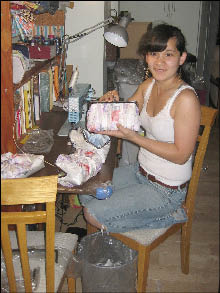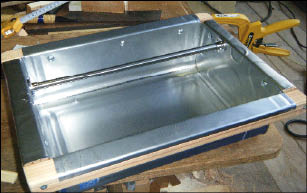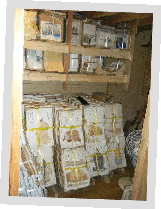Message from Collectors
In the previous issue, I asked readers for some 'thoughts' on the recently completed Solitudes print series. Here are a couple of the contributions, both from long-time collectors. (And thanks very much to both of you for this!)
from Mark Roberts in Canada
When I first heard about the Solitudes series I knew I would have to collect it. The premise of the series neatly aligned with my most cherished memories of Japan.
I started collecting Dave's work during an expat assignment in Tokyo in the early 1990s. Coming from smallish cities in Canada, Tokyo's population and all the hustle and bustle of the high-technology business climate back then was a real strain on my system, but I enjoyed learning about the culture of Japan, including wood-block prints, and was excited to find someone that I could talk to on the subject in English!
In my second year of the assignment I felt comfortable enough to dedicate almost every weekend to day-trips, either into back-street areas of the city where craftsman had their shops or alternatively into the countryside. I started collecting my own set of 'solitudes' that included certain less frequented parks and gardens, the remote forest shrines in Nikko, and natural hot springs, waterfalls, etc. found on mountain trails near a friend's cottage.
'My Solitudes' by David helped me to recall what I enjoyed the most from my time in Japan. His observations and sentiments expressed in the stories resonated strongly with my own recollections of the beautiful natural areas of Japan. I have always felt that many Japanese people don't appreciate what the countryside offers and may not even venture down a less-traveled path to see what's around the next bend.
Even in the busiest areas of the city it is often possible to find an undeveloped 'natural' area, a quiet park or garden to escape for a few minutes from the pressures of big-city life. David's writings in 'My Solitudes' strongly hinted of that with his details on the short journeys required to reach many of the locations.
The combination of the prints and stories will quickly transport you to the time and place that David is relating. His stories make the print come alive and at the same time will give you a new appreciation for nature conservation, covering both benefits and issues associated with these 'freaks of nature' in Japan's urban landscape.
* * *
from Shigeyoshi Ushiro of Mie Prefecture
We have now moved into the season where we are tormented by the heat, but the 'busy as ever' David makes me think that he must be powered by atomic energy!
David's 'Solitudes' series was such a long journey! Carried by his courage and ability to bring us small details, I was thrilled and delighted to appreciate the experiences that I myself would be too afraid to enjoy alone in the mountains.
It is perhaps not so polite to say this to a printmaker, but I have to admit that when reading the stories, I sometimes forgot about the prints.
The quietness of David's prints could be considered to be a weak point, but this is his artistic style. Some famous best-selling artists work in bold performance fashion, but David searches out themes that no others do, and creates wonderful works to send us. We always enjoy the works from this sensitive and sincere man.
Although I myself am thankful for David's reasonable pricing policies, if I were to be asked if this were the true value of his work, I would be unable to answer anything but 'no'. I am sure that it is not only I who feels this way each time we receive one of the packages. I hope that the series can soon become sold-out!










 The mixture of glue and alum is dissolved slowly in a double-boiler.
The mixture of glue and alum is dissolved slowly in a double-boiler. It is then strained to remove impurities and lumps.
It is then strained to remove impurities and lumps. The small thermometer helps me keep the mix at the proper temperature.
The small thermometer helps me keep the mix at the proper temperature. This is the most difficult part - applying a perfectly smooth coat of size across the sheet.
This is the most difficult part - applying a perfectly smooth coat of size across the sheet. I built clip units that let me hang the paper up without creases.
I built clip units that let me hang the paper up without creases. It is important to let the paper dry slowly, or it will buckle as it shrinks.
It is important to let the paper dry slowly, or it will buckle as it shrinks. The only brush I could find is 1 shaku in width, but this is far too narrow to cover a single sheet of paper in one pass. I have been forced to cut my sheets in half before beginning, thus doubling the working time. (Although of course working on smaller sheets makes it 'easier' for this beginner!)
The only brush I could find is 1 shaku in width, but this is far too narrow to cover a single sheet of paper in one pass. I have been forced to cut my sheets in half before beginning, thus doubling the working time. (Although of course working on smaller sheets makes it 'easier' for this beginner!) All the sheet-metal shops in my community have closed, so I built my own sizing tray, making it match the brush. It is used in double-boiler fashion, standing in water heated by a hot plate.
All the sheet-metal shops in my community have closed, so I built my own sizing tray, making it match the brush. It is used in double-boiler fashion, standing in water heated by a hot plate. These custom hangers turned out to be a good idea. It is very difficult to hang up the wet and soft paper, but I prepared dozens of these using smooth-faced clothespegs (made for use with lingerie). This part of the job is now no problem!
These custom hangers turned out to be a good idea. It is very difficult to hang up the wet and soft paper, but I prepared dozens of these using smooth-faced clothespegs (made for use with lingerie). This part of the job is now no problem!
 The genkan (entranceway) is a great place to store the remaining scrolls in their paulownia boxes - the constant fresh air is good for them!
The genkan (entranceway) is a great place to store the remaining scrolls in their paulownia boxes - the constant fresh air is good for them!









